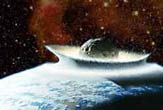Fossils Suggest Chaotic Recovery from Mass Extinction

Insect bite marks in ancient leaf fossils are shedding new light on how nature bounced back after an asteroid impact killed off the dinosaurs and much of life on Earth 65 million years ago.
Plant and insect biodiversity is strongly linked today: Where there are many types of plants, there are many insects to eat them. But after the mass extinction, the devastated plant and insect populations might not have been so in sync, according to a new study.
"The recovery from a mass extinction was more interesting and chaotic than we thought," said study leader Peter Wilf, a paleontologist at Pennsylvania State University.
Clearing the slate
The demise of the dinosaurs after this event, known as the K-T extinction, later brought about a restructuring of the animal world and the rise of mammals. But it initially marked the end of the biologically rich Cretaceous period and the beginning of the more anemic Paleocene epoch. Most Paleocene fossil sites show both low numbers of plants and insects.
But scientists have discovered two sites in the western United States that show remarkable biodiversity—one in plants, and one in insects. Paleontologists looked at leaf fossils for signs of the bite marks left by different species of insects.
At one site, near Denver, the fossils showed that "the plant diversity was really high—like a modern rainforest," Wilf said. "It was a big shock."
Sign up for the Live Science daily newsletter now
Get the world’s most fascinating discoveries delivered straight to your inbox.
Wilf and his colleagues suspect that the plants were able to flourish because the ancient climate at the site was warm and wet.
But the leaves unexpectedly showed few signs of insect predators. Wilf thinks the leaves were too hardy for insects to gnaw on. "It probably wasn't a good place for them to get started again," he said.
A new leaf...
But what really surprised paleontologists were the fossils at another site in Mexican Hat, Montana that showed just the opposite relationship. The leaf fossils found there were more typical of those discovered at other Paleocene sites. But the insect bites left on them indicated a teeming insect population. [Image]
Wilf and his team haven't found any other sites that show evidence of such a robust insect population. "We don't know where [the insects] went or where they came from," he said.
Wilf believes these unusual fossil records show biodiversity recovery is more interesting than previously thought.
"This may be a general pattern in the fossil record; it's certainly an interesting pattern in the fossil record," he said. "It's something that people can look for."
Related Story
Explore Dinosaurs
- Scientists Debate Dinosaur Demise
- The Biggest Carnivore: Dinosaur History Rewritten
- How Dinosaurs Might Have Walked
- A Brief History of Dinosaurs
- All About Dinosaurs
Asteroids and Dinosaurs

Andrea Thompson is an associate editor at Scientific American, where she covers sustainability, energy and the environment. Prior to that, she was a senior writer covering climate science at Climate Central and a reporter and editor at Live Science, where she primarily covered Earth science and the environment. She holds a graduate degree in science health and environmental reporting from New York University, as well as a bachelor of science and and masters of science in atmospheric chemistry from the Georgia Institute of Technology.









